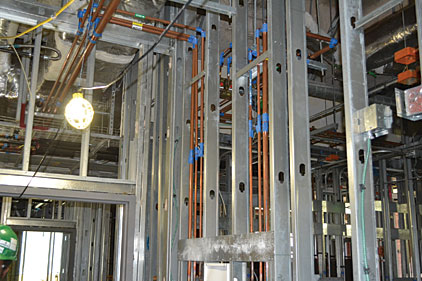Originally made up of two teaching hospitals, the Louisiana State University Health Sciences Center in New Orleans (commonly known as the LSU Medical School in New Orleans) was forced to shut its doors in the wake of Hurricane Katrina in 2005.
While one of the facilities — the University Hospital — reopened in fall 2006, its counterpart, Charity Hospital, suffered severe damage and has remained closed since the storm hit.
After reopening in 2006, the University Hospital temporarily changed its name to Interim LSU Public Hospital under FEMA guidelines and immediately provided 85 beds for both primary- and specialty-care patients. While the number of beds continues to grow, staffing the hospital remains challenging as the city continues on a path to full recovery.
A new beginning
In the spring of 2007, the Louisiana Office of Facility Planning and Control presented a business plan to replace Charity Hospital and University Hospital with an entirely new academic medical center. In partnership with the Department of Veterans Affairs, construction on a new $1.2 billion facility started in 2010 with the goal of attracting the world’s top medical professionals and students.
The 1.1 million-sq.-ft. facility, known as the University Medical Center of Louisiana, will deliver high-quality health care, advanced research and Level One trauma care. It will house 457 hospital beds as well as a 75,300-sq.-ft. diagnostic center. The new hospital also will serve as a major training center for medical students attending LSU, Tulane, Dillard, Xavier, Southern University at New Orleans, Delgado and other health-care teaching schools throughout southern Louisiana.
Now under the management of the Louisiana Children’s Medical Hospital, the project’s construction is expected to be completed by spring 2015 with one major goal in mind: making the building hurricane-proof.
Copper is key
In order to prevent the same destruction caused by Hurricane Katrina from occurring again, UMC is being built using structural steel and will feature $1.5 million in copper-intensive plumbing and piping systems to ensure the utmost safety of its patients, students and employees. As much as 40% of the mechanical systems for the project have been prefabricated and brought to the site to ensure construction stays on target. The medical center has been designed to meet flood-resistant construction standards and will include:
- Floors 2 and above, which will house critical functions, to be built at least 22 ft. above sea level;
- Storm-proofing technology that will allow the medical center to withstand hurricanes up to a Category 3, as well as tornadoes, nuclear or biological accidents, physical attacks, fires, chemical, biological and radiation hazards; and
- Emergency electrical backup power that will allow the building to remain in operation for up to a week without outside support or backup supplies.
The PE on the project is URS Corp.’s Martin Zakes, PE LEED AP BD+C, is impressed with how quickly the construction is coming together.
“The pace of construction has been very fast. Forming the joints on an assembly line instead of in the ceiling has produced a very high-quality result,” he said. “Prefabricated racks and virtually modeling the construction have helped with coordination of the trades.”
Upon its completion, the combined UMC and VA medical centers are expected to generate $1.26 billion each year for the state and create more than 19,700 permanent jobs in the New Orleans area.
“The University Medical Center will be a real shining star for New Orleans,” says Greg Firn, president and COO at the http://www.chnola.org/Louisiana Children’s Medical Center. “When it opens, it will be great for the city in the sense that it will bring in top talent from the medical field — a real destination medical center.”
Reliability where it matters most
In a hospital setting, safety measures must go far beyond basic patient care, starting with the development of safe and sustainable structures. Known for being one of the most durable and versatile metals, copper is preferred in many areas of building construction, including plumbing and piping systems.
But why? Unlike other materials, copper is long-lasting, corrosion-resistant and requires little maintenance. Many plumbers and contractors find it easy to work with copper.
“I’ve never found it challenging to work with copper tube and pipe,” says Dale Dumbleton, project manager at New Orleans-based Mechanical Construction, which is installing the plumbing and medical gas systems in the new hospital. “Our company has worked with the metal for 45 years. This project has been a real pleasant experience for us.”
Because of its reliability, copper is the preferred material used to build medical gas piping within health-care facilities. Medical gases are used extensively throughout hospitals, transporting nonflammable gases such as oxygen, nitrous oxide, medical air, carbon dioxide, helium, nitrogen, instrument air or any mixture thereof to patients receiving life-saving treatments.
Zakes admits there were some concerns about using copper before the team agreed it was the correct choice for the project.
“There were initial concerns, with the volatility of copper pricing, that stainless steel may need to be substituted in certain applications,” Zakes said. “In the end the copper proved to be more economically feasible.”
Hospitals and other medical facilities also use copper to operate life-saving tools, surgical and treatment equipment and the medical vacuum system, which removes gases and fluids from patient-treatment and surgery areas. In total, nearly 13 miles of medical gas piping in 11 different tube sizes will be installed at the new facility to better serve its patients.
“When it comes to piping systems, it’s not exactly ‘one size fits all’,” says Dale Powell, project manager and piping applications specialist at the Copper Development Association. “Based on the amount of medical gas needed and the level of pressures required, you have to determine what size is best for each application — from tubes as large as 8 in. in diameter to some as small as half-inch.”
For patients relying on such gasses, proper delivery or lack thereof can result in life or death. Copper systems provide strong, leak-tight systems that ensure gases are delivered to equipment and patients at necessary pressures. Copper is impermeable, so it prevents outside substances, including chemicals from accidental spills, from contaminating the gas stream.
The UMC will use its largest piping on the sixth floor where medical air compressors and vacuum pumps will be located. However, the building has miles of medical gas piping located on each floor, in addition to eight vertical pipe shafts.
Copper piping does not support the growth of microbial bacteria, which helps ensure the purity of the gasses as they reach the patient. With the ability to prevent buildup of microbial growth inside the piping, copper not only maintains the quality of gas delivered, but prevents gas flow from being restricted. This is crucial when it comes to extending the life of a hospital’s piping systems and maintenance of the building’s infrastructure.
Furthermore, copper has a comparatively high melting point, making it much less likely to aid in the spread of flames in the event of a fire. Unlike other materials, copper doesn’t burn and won’t produce additional smoke. These nonflammable capabilities are especially significant in hospitals where people are less mobile.
Copper for mechanical systems
The advantages of copper piping extend far beyond medical gas systems. When it comes to plumbing and mechanical piping, including water distribution, drainage and vent systems, as well as heating and cooling applications, copper can easily be prefabricated for shipment to the jobsite or fabricated directly on-site using various joining systems to allow for site conditions and final connections.
In addition to medical gas systems, the UMC will use copper piping for its plumbing and mechanical systems (such as domestic water distribution) throughout the hospital. Drinking fountains, water closets, sterilizers, scrub sinks and more will all rely on copper to function, as well as air compressors and vacuum pumps.
Copper can handle extreme conditions (more than 1,000 psi) and can withstand exposure to ultraviolet rays (sunshine, hospital cleaning/disinfection equipment) and exposure to onsite water disinfection systems (chlorine dioxide generation, copper-silver ionization, etc.). These factors make copper plumbing extremely durable.
Again, copper plumbing can resist extreme temperatures (so it won’t burn and release toxic gasses) and can withstand repeated freeze-thaw cycles (although, of course, no plumbing should be allowed to freeze).
It is bacteriostatic, so bacteria will not grow within the system and contaminate water systems. Also, there is no risk of lead exposure since copper tube and fittings are 100% lead-free and have been since they were introduced in the U.S. nearly 80 years ago. For these reasons, UMC will use nearly 35 miles of copper piping to ensure the longevity and reliability of its plumbing and mechanical systems.
In the long run, copper plumbing requires less maintenance and fewer repairs. Furthermore, installation of copper tube does not require solvents that contain volatile organic compounds, so using copper will not harm the environment or the installers.
There are nearly 130 plumbers and pipefitters from around the U.S. working together on the hospital project. Previously trained (some personally by CDA), these professionals provide the highest quality when it comes to installing copper piping systems behind the walls of the UMC.
Looking forward
With the FEMA trailers on the southern Louisiana landscape now gone and the 53 broken levees rebuilt, New Orleans has come a long way toward recovery. However, after more than $81 billion in damage, the work remains ongoing as the city breaks ground on new projects each year.
Three years in the making, the UMC is expected to meet projected patient volumes and create reasonable economic growth while accommodating the clinical and medical education needs of the entire state.
A true representation of how far the city has come since 2005, the hurricane-proof medical facility, complete with durable copper piping systems, will be a focal point of health-care excellence for decades to come.
Andrew G. Kireta Jr. is the vice president of market development for the Copper Development Association., and is responsible for the use of copper and copper alloy systems and products in building construction, sustainable energy, piping and mechanical system applications. He has been active with CDA since 1992, is a graduate of Purdue University and holds a Bachelor of Science degree in Mechanical Engineering.

